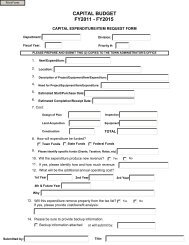Town Center Subbasin Study Report - Bellingham Massachusetts
Town Center Subbasin Study Report - Bellingham Massachusetts
Town Center Subbasin Study Report - Bellingham Massachusetts
- No tags were found...
You also want an ePaper? Increase the reach of your titles
YUMPU automatically turns print PDFs into web optimized ePapers that Google loves.
The designed retrofit plan results in a 41% reductionat a cost of $467,715. Appendix A summarizes thecomplete results of this plan and detailed designs forthe ten priority sites are shown in the previous section.Scenario 1: Stormwater Control Design Size OptimizationScenario 1 was created through a model optimizationset to minimize costs while meeting the target fortotal phosphorus removal. The optimization variedthe stormwater control volume for the stormwatercontrols in each Drainage Area and looked for theoptimal combination of stormwater control treatmentsto minimize costs. No upper or lower bounds wereset on stormwater control treatment volumes,however, resultant control unit sizes are checked atthe end of a model run to make sure they will fit on aparticular site. In general, the optimization runs spreadreductions over more stormwater controls so they areusually smaller not bigger than the initial size. In thisScenario and in Scenario 2 no fixed target reductionwas set for the DD sites, as it was in Scenario 0 . Typeof stormwater control and location for each drainagearea, however, were fixed during the optimization runin accordance with Scenario 0. Site 028-A was againfixed at 41% in both optimization runs.The optimized scenario results in a 41% reduction inthe phosphorus load in stormwater runoff at a cost of$264,750. Since Scenario 1 is the result of a numericoptimization it does not account for some factors thatwould affect feasibility of implementation in the realworld such as public opinion, neighborhood character,and site aesthetics. Complete results for this plan arepresented in Appendix A.Scenario 2: Stormwater Control Type and Design SizeOptimization ResultsScenario 2 is also a model optimization. This scenariodiffered from Scenario 1 in that stormwater controltypes were not fixed. For each Drainage Area, CRWAdetermined which stormwater controls were physicallyfeasible on the site given space constraints, slopes,and mapped soil conditions. The optimizationmodel selected the preferred stormwater controlfor each Drainage Area from the suite of allowablestormwater controls for that Drainage Area. Themodel also varied the stormwater control designstorm depth to determine the best overall treatmentplan. Scenario 2 meets the target net reduction of41% at a cost of $212,540. Scenario 2 is also the resultof a numeric optimization that does not take intoaccount some factors that would affect feasibility ofimplementation in a real world scenario such as publicopinion, neighborhood character, and site layoutand aesthetics. Complete results for this plan arepresented in Appendix A.DiscussionThe model optimization results (S1 and S2) both hadfewer drainage areas receiving no stormwater runofftreatment when compared to the initial stormwatermanagement plan (S0). Scenario 0 has 14 drainageareas receiving no treatment versus only 3 in Scenario1, and 9 in Scenario 2 (Table 3 and Figures 8, 9 and10). Scenario 1 includes more systems treating smallerwater volumes from more Drainage Areas. Since moststormwater controls deployed in this plan have asmaller treatment volume, they fall on a steeper part ofDrainage Area S0 S1 S2DD1-A 51% 5% 59%DD1-B 51% 35% 51%DD2 51% 4% 64%DD3 51% 29% 30%Table 4. Summary of PH reduction for DD sites by scenario33the removal efficiency curve. By employing multiplestormwater controls, each treating small water qualityvolumes, the result is greater aggregate phosphorusremoval across the study area at a similar overalltreatment volume, and a reduced cost. This result isalso consistent with the general principals of LID inwhich smaller, onsite systems are encouraged.Additionally, the results for S1 and S2 both includea small number of drainage areas in which relativelylarge treatment volumes are proposed to achieveover 90% phosphorus removal, whereas S0 has noindividual units treating large enough volumes toreach this removal percentage. The optimization toolis extremely beneficial in identifying units that areboth over- and under-utilized.In Scenario 0, DD drainage areas were designed tomeet a 51% reduction, but in the optimized scenariostarget reductions for these sites were not fixed. Table4, below, summarizes the resulting target reductionsfor these three sites (DD1 is subdivided into two subdrainageareas for design reasons, see pages 18-19)from each of the modeling scenarios. The Scenario 2results exemplify a situation in which it may be lessStormwater Control S0 S1 S2Bioretention System 4 4 2Infiltration trench 2 3 0Rain Garden 2 2 2Infiltration Basin 6 16 14Infiltration Chamber 1 1 1Green Street/Tree Filters 0 0 0Vegetated Swale 0 0 0Gravel Wetland 0 0 0Wet Extended DetentionBasinDry Extended DetentionBasin0 0 00 0 0Table 5. Stormwater control type by scenarioModeling Analysiscostly for the overall stormwater management plan tohave sites DD1 and DD2 construct larger infiltrationbasins to reduce the phosphorous load by greater than51% (plus 14% through non-structural stormwatercontrols for a total of 65%).Conversely, if the owners of sites DD1 and DD2 areopposed to incorporating some stormwater controlsbecause of existing conditions on their property, itmay make sense for them to employ smaller units assuggested in Scenario 1 and financially assist othersites in achieving greater reductions to make up thedifference. A watershed-wide optimization model canhelp guide these types of real world decisions. Thevarious modeling scenarios also differed in the types ofstormwater controls employed in each drainage area.In Scenarios 0 and 1, the stormwater control type wasfixed, however, Scenario 1 proposes implementationof more stormwater controls than Scenario 0. InScenario 2, the stormwater type was selected throughthe optimization program. Table 5 summarizes thestormwater control types selected in each scenario.The most cost-efficient stormwater controls forphosphorus removal are those systems that havea high efficiency of phosphorus removal and a lowconstruction cost per volume of water treated. Figure14 in Appendix B illustrates the cost-effectiveness ($/ft2 of treated area) of various stormwater controlsfor the removal of 65% total phosphorus. Infiltrationbasins have very high phosphorus removal efficiencyand a moderate cost so they end up being small,cost-effective systems for removing phosphorus. Incontrast, dry extended detention basins are cheapcontrols to construct but have very low phosphorusremoval efficiency, and therefore end up being verylarge, so they are not cost-effective for phosphorusremoval.






